
High-intensity training refers to high effort, low volume, and lower frequency training. We’ll cover the precise details shortly.
But often, high-intensity training is contrasted to high volume and perhaps more frequent training, the training style many iconic figures during the Golden era of bodybuilding, such as Arnold, are known to have performed and recommended.
In this article, we’re going deep into high-intensity training to figure out if it’s truly the optimal muscle-building way, as well as compare it to higher volume and more frequent training regimes.
Table of Contents
- Part I: History of High-Intensity Training
- Part II: Common Themes of High Intensity Training
- Part III: The Colorado Experiment: 63lbs of Muscle in 28 days
- Part IV: Training to Failure vs Not
- Part V: Low Volume vs High Volume
- Part VI: Low Frequency vs High Frequency
- Part VII: Positives of High-Intensity Training
- Part VIII: Conclusions

Part I: History of High-Intensity Training
Numerous different variations of high-intensity training exist, and famous bodybuilders such as Mike Mentzer and Dorian Yates were known to train in this style.
However, many folks (including Mentzer and Yates) credit Arthus Jones for popularising high-intensity training in the 1970s. The term “high-intensity training” appears as early as 1973 in an article by Jones. Jones’ further writings on the topic can be found in his numerous magazine and book writings.
Who was Arthus Jones?
He founded Nautilus, a company that manufactured training machines, machines designed to match the strength curves of a muscle.
Jones was far from the typical man. He travelled extensively. His motto was “younger women, faster airplanes, and bigger crocodiles”.
A Nautilus building in Florida was home to a Gomek, an 18-foot saltwater crocodile Jones wanted to grow to record size.
He ran businesses that imported wild animals and is believed to have owned a zoo in Louisana after the 2nd world war.
Part II: Common Themes of High Intensity Training
We noted many variations of high-intensity training exist. But 3 common themes are consistent throughout all variations.
The first is the emphasis on training to failure and sometimes even beyond.
Arthus Jones instructed in his Nautilus Bulletin books, “a set is properly finished only when additional movement is utterly impossible, curl until you can’t even begin to bend your arms, squat until you can’t start up from the low position, press until you cannot move the bar away from your shoulders and chest”.
Mike Mentzer’s stated in his book “working to this point of failure, when another rep is impossible despite the greatest effort, ensures you pass through the break-over point, a point in the set below which growth cannot be stimulated, and above which growth will be stimulated”.
The second common theme is performing a low number of sets per exercise, typically only one set.
In another Arthus Jones’ book, he says “how many sets of the exercise? one. Additional sets usually serve no purpose and may produce a state of overtraining with some subjects”.
A quote by Dorian Yates reads “One set at extreme intensity does the muscle-building job”.
The third main common theme is the low frequency of training.
Arthur Jones initially advocated for three full-body weekly workouts, but later amended to training each muscle only once or at most twice per week, he states “how many weekly workouts, not more than two, and some people will produce better results from only one weekly workout. More is not always better, and in the case of exercise is usually worse”.
Mike Mentzer echoed this, recommending 96-120 hours of rest between training sessions. In fact, Mentzer also states in his book he had a number of personal clients who trained once every 10-14 days.
All three themes are closely connected.
High-intensity advocates suggest when training with true maximal effort (as you do when training failure), you can only perform so much volume (hence the one set recommendations), and only so frequently too (hence the low-frequency recommendations.
As Arthus Jones describes “The secret, if there is one, is high-intensity. And when you actually train with high-intensity, you don’t need a lot of volume.”
Likewise, Mike Mentzer states “If you’re skeptical [of Heavy Duty’s low volume], your subconscious child is telling you that more is better. In some cases, that’s true. More money is better than less. But you can’t take that principle and blindly apply it to exercise and expect to get anything out of it.”
Heavy duty was the name of Mike Mentzer’s high-intensity training style.
Now we have a good understanding of what high-intensity training is, is this method of training truly superior for muscle hypertrophy and strength?
A few stories exist of individuals allegedly gaining an incredible amount of muscle mass with high-intensity training in a short time, with the Colorado experiment being the most fascinating.
Part III: The Colorado Experiment: 63lbs of Muscle in 28 days
63 lbs of muscle in 28 days through high-intensity training? Allegedly the infamous Colorado experiment found this.
The experiment took place in 1973, at the Colorado State University under the supervision of Dr. Elliot Plese.
In this experiment, Casey Viator (a successful bodybuilder, who was actually the youngest ever AAU Mr. America winner at the age of 19) trained high-intensity style for 28 days, while Arthus Jones himself trained for 22 days.
The program is believed to look like this, at least something along these lines:
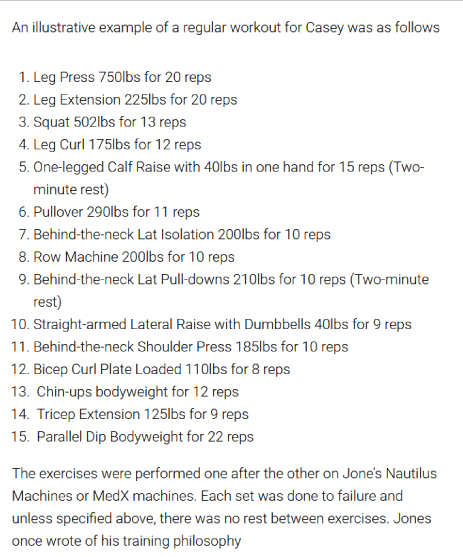
One set was performed to failure in the prescribed rep ranges, and all exercises were performed with no rest between them. All exercises were performed on Nautilus machines too.
The findings were published in the September ironman magazine in 1973.
Viator gained 63.21lbs of muscle and Arthu 15.44lbs of muscle.
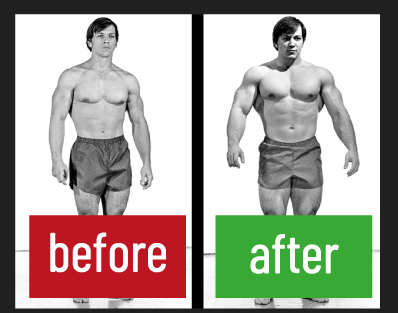
Incredible results, but are they too good to be true?
Likely, I’d argue yes.
In the 4 months before this experiment, Casey Viator was believed to not have trained at all, as he was recovering from a serious accident at work.
Similarly, Jones was believed to not have trained in the 4 months preceding the Colorado experiment, yet he had training experience in the past and at one point was believed to have been a muscular 205lbs.
As a result, muscle memory (the phenomenon where your body can quickly rebuild lost muscle) is certainly confounding this experiment.
Aside from this, Casey at least was clearly a gifted individual for putting on mass, so genetics are a consideration, something Arthus Jones did make clear.
I think the use of anabolics cannot be ruled either.
Now, Arthus Jones was opposed to anabolics, something he expressed many times in his writings.
In a report on the Colorado experiment, Jones is reported to have said “the use of so-called growth drugs is neither necessary nor desirable.”
Moreover, in a T-nation article by Ellington Darden, someone who worked with Arthus Jones, it’s reported Jones hired someone to shadow Casey to ensure no anabolics were used.
Despite all this, I still think it’s impossible to rule out the possibility of anabolics, even if Casey did not use during the 28 days, prior use can presumably still influence things.
Aside from the Colorado experiment, Ellington Darden also put forth other accounts of individuals gaining abnormal amounts of muscle mass with high-intensity training in the T-nation article:
- David Hudlow built 18.5 pounds of muscle in 11 days. Documented in The New High-Intensity Training.
- Eddie Mueller built 18.25 pounds of muscle in 10 weeks. Documented in Massive Muscles in 10 Weeks.
- Todd Waters built 15.25 pounds of muscle in 6 weeks. Documented in High-Intensity Strength Training.
- Jeff Turner built 18.25 pounds of muscle in 4 weeks. Documented in GROW.
- Keith Whitley built 29 pounds of muscle in 6 weeks. Documented in Bigger Muscles in 42 Days.
- David Hammond built 22.5 pounds of muscle in 6 weeks. Documented in Bigger Muscle in 42 Days.
- Joe Walker added 17.38 pounds of muscle in 6 weeks. Documented in The Body Fat Breakthrough.
- Shane Poole built 19.34 pounds of muscle in 6 weeks. Documented in The Body Fat Breakthrough.
Furthermore, I also came across an article by Tim Ferris, the author of the popular 4-hour work week, describing how he used Arthur Jones’s high-intensity style training to put on 34lbs of muscle in 4 weeks.
So what are we to make of all these accounts?
Do they prove high-intensity training is the ultimate muscle hypertrophy system?
In my view, no.
As alluded to, many plausible confounders exist. The anecdotal data are also difficult to verify, and none of these experiments COMPARE how high-intensity training differs from other training methods.
Something that does compare how different training methods compare is experimental research.
With each of the three themes of high-intensity training, we can examine what the experimental research says about them.
In my opinion, this is a much better way to evaluate the efficacy of high-intensity training.
Part IV: Training to Failure vs Not
We noted training to failure is one theme in all high-intensity training protocols.
But is training to failure truly needed to maximize hypertrophy and strength?
Starting with hypertrophy, in 2021, Grgic et al. conducted a meta-analysis of all the available evidence.
For the unaware, a meta-analysis statistically combines all the current evidence on a topic, thus increasing statistical power and reliability when done well.
Based on 7 studies (collectively comprising 130 men and 89 women), there was no difference in muscle growth between training to failure and not training to failure.
After independently assessing the involved studies, most had the non-failure training groups leave 3 to 0 repetitions in reserve (that is, they stopped 3 to 0 reps away from failure), thus it seems training with this is similar to training to failure.
Having said this, a subgroup analysis of studies done on trained individuals only did find training to failure to be better than not training to failure.
However, a major limitation is only 2 studies were involved in this subgroup analysis, and both of these may not necessarily suggest training to failure in trained individuals is truly superior.
In the one study by Karsten et al., they found leaving 5 reps in reserve was inferior to training to failure, thus this study only suggests training to failure may be better than leaving 5 reps in reserve. It does not tell us how leaving 3 to 0 reps in reserve could compare to failure training in trained folks.
The other study included in the subgroup analysis was by Pareja-Blanco et al., and it found failure training was better for overall hypertrophy versus non-failure training. However, this was a velocity-based study, they had subjects terminate their sets once their lifting velocity decreased by a certain percentage, so it’s difficult to know what reps in reserve the non-failure training group used. But based on some data provided, it seems the non-failure group may have been training with 5 or more reps in reserve. For example, this group seemed to perform only around 5 reps with a 70% one-rep max load, fairly far from failure.
Thus, again, this study does not inform us of how leaving 3 to 0 reps in reserve may compare to failure training.
Fortunately, since this analysis by Grgic et al. in 2021, a study by Santanielo et al. has emerged.
These researchers ultimately established in men with an average of 5.1 years of training experience, leaving mainly 3 to 0 repetitions in reserve was similar to training to failure for hypertrophy.

Thus, trained folks may also experience optimal gains while stopping 3 to 0 reps away from failure.
Mechanistically, I’d argue these findings make sense.
When we think about what causes muscle growth, training to failure probably does not provide any more benefit than stopping 3 to 0 reps from failure.
Allow me to explain.
Back in 2010, Brad Schoenfeld published a famous paper postulating that mechanical tension, muscle damage, and metabolic stress are all drivers of muscle hypertrophy.
Fast forward to 2019, Brad Schoenfeld teamed up with Wackerhage and others to create an updated paper.
They detail how the evidence behind metabolic stress and muscle damage being drivers of hypertrophy is not clear cut. Many cases exist where more metabolic stress or more muscle damage are not associated with more hypertrophy.
Conversely, the evidence seems to demonstrate mechanical tension as the most likely and potent hypertrophy stimulus.
In other words, we have solid reasons to believe mechanical tension is the primary driver of hypertrophy.
And when we understand what precisely mechanical tension is, there’s evidence training to failure does not produce higher levels versus stopping 3 to 0 reps shy of failure.
Let’s dive into this a little further.
Mechanical tension is equal to the force generated by muscle fibers.
Components within muscle fibers, called mechanosensors, detect forces produced by the muscle fiber and transduces these forces into a signaling cascade that results in muscle protein synthesis (which are the proteins that make our muscles bigger).
The concept of motor units helps us understand overall mechanical tension further.
A motor unit refers to a single motor neuron (that originates from the spine) and the multiple muscle fibers it innervates. When the single motor neuron sends an electrical signal through to the muscle fibers it innervates, those muscle fibers produce force.

Within a whole muscle, different motor units exist, and their characteristics lie across a spectrum.

On one end are low threshold motor units, and on the other end are high threshold motor units.
Typically, a low-threshold motor unit consists of a small motor neuron that innervates slow-twitch muscle fibers that produce low amounts of force but are highly fatigue resistant. Due to this, low-threshold motor units are described as highly fatigue resistant but low force-producing.
A high-threshold motor unit generally consists of a large motor neuron that innervates fast-twitch muscle fibers that produce high amounts of force but are highly fatigable. Therefore, high-threshold motor units are described as high-force producing but very fatigable.
For maximizing overall mechanical tension (and thus the stimulus for overall muscle growth), we’d want to recruit as many motor units as possible during an exercise (from the low-threshold motor units all the way up to the high-threshold motor units).
We’d also want each of the motor units to be producing decent amounts of their respective force capacities for a fair duration.
Here’s the main points:
Firstly, It’s not clear when you reach maximal motor unit recruitment, and the motor unit literature indicates this can differ between muscles.
However, the literature indicates this is likely achieved a while before failure.
For instance, one study suggests maximal motor unit recruitment for the shoulder and trap muscles may be obtained 3-5 repetitions before failure.
Secondly, by the time you’ve reached failure, many motor units are likely past-producing their highest forces and are just fatiguing.
Remember, it’s tension (analogous to force) that’s categorized as a prime stimulus for muscle hypertrophy. The idea that more motor unit fatigue is beneficial for muscle hypertrophy is not supported by the current literature.
A motor unit modeling study by Potvin and Fuglevand demonstrates our points nicely.
Their model included 7 different motor units, ordered in terms of thresholds.
Motor unit 1 was the lowest threshold motor unit, while motor unit 120 was the highest threshold motor unit.
The graph below depicts the contribution of each motor unit to a 50% maximal isometric contraction held until failure. The total contraction lasted 100 seconds.
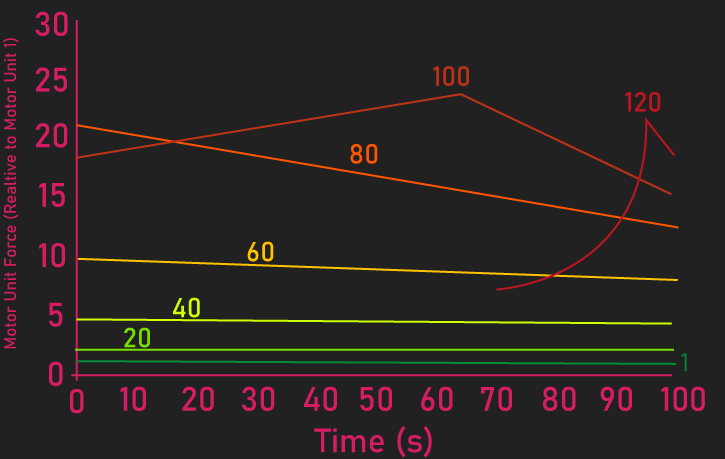
Except for motor unit 120, all of the other motor units were recruited from the start of the contraction.
Motor units 1, 20, 40, and 60 produced steady low forces throughout the full contraction duration. This makes sense, these would be considered the low-threshold motor units (which produce low forces but are highly fatigue resistant).
Motor unit 80, a higher-threshold motor unit, produced its most force for the set at the start of the contraction, where it thereafter gradually fatigued.
Motor unit 100, a higher-threshold motor unit, continued to increase its force contribution up until the 65-second mark, and thereafter began to fatigue.
Motor unit 120, the highest-threshold motor unit, was recruited at the 70-ish second mark, and steeply increased its force contribution up until the 95-ish second mark, where it then steeply fatigued.
This data demonstrates motor unit recruitment, as well as the maintenance of at least decent amounts of force production from the individual motor units, is achieved before failure. At the point of failure, no additional motor units nor enhancements in individual motor units force occurred.
This probably explains why leaving 3 to 0 repetitions in reserve is sufficient for muscle growth.
I should restate this data was from modeling isometric contractions.
Recruitment patterns and strategies likely differ between isometric and the isotonic contractions that occur during typical exercises.
Yet, I’m unaware of any reason to believe the main points (that failure offers no additional motor unit recruitment or enhancements in individual motor units force) would not also be the same with isotonic contractions.
Moving on, is training to failure needed to max strength gains?
The Grgic et al. meta-analysis found based on 15 studies (collectively comprising 265 men and 129 women), there was no difference in gains between failure and non-failure training.
A subgroup analysis also found the results stayed true for trained individuals.
After independently assessing the studies, most of them seem to have had subjects leave between 5 to 0 repetitions in reserve. So training with 5-0 reps in reserve may be similar to failure training for producing strength gains.
Making this section clear, training to failure does not seem to promote additional hypertrophy or strength adaptations.
Before moving on, if you’re curious about creating an effective training program for muscle hypertrophy, our high quality partner Alpha Progression can help. It can generate a highly effective program for you, track your workouts live with in-built progression recommendations, provide graphs displaying your long term progress, and it has a massive exercise database with more than 550 exercises.
Click HERE (the link opens in a new tab) to get a free 2 week trial of the apps features. If you like it and go beyond, the link also gives you 20% off a subscription!
We never promote trash at the House of Hypertrophy, so rest assured the app is high quality. The reviews speak to this, 4.8 starts (based on more than 7,000 reviews) on Google play, and 4.9 stars in Apple’s store (based on nearly 400 ratings).
Part V: Low Volume vs High Volume
Recall that high-intensity folks advocate low volumes, typically only one set per exercise.
Does the literature support this recommendation?
In 2017, a meta-analysis by Schoenfeld et al. combined the results of 15 studies comparing low to high volume training.
Of the 15 studies, 14 had the low volume groups train with 1 set per exercise, while the high volume groups trained with 3 sets per exercise.
It was found high volume was better than low volume for increasing muscle mass.
Since 2017, three additional studies published also indicate performing 3 sets per exercise produces more muscle growth than performing 1 set (one, two, and three).
Why is this?
It seems the higher volume attained with 3 sets ultimately stimulates the anabolic pathways within muscle fibers more.
Demonstrating this, a 2010 study by Burd et al. compared fed-state myofibrillar protein synthesis after training with either 3 or 1 set of reps to failure on the leg extension with a 70% one-rep max load.

Performing 3 sets resulted not only in a greater fed-state myofibrillar protein synthesis amplitude but also a longer duration versus performing the 1 set.
What about strength adaptations, how do low and high volumes compare for this?
For this, we have a 2017 meta-analysis by Ralston et al.
They combined 9 studies comparing low vs high volumes for strength. 7 of the 9 studies had the low volume groups train only one set per exercise, and the high volume groups train with 3 sets per exercise.
It was found strength gains were greater with the high volumes, indicating that 3 sets per exercise produce greater strength than 1 set.
So overall, the current literature indicates that 1 set per exercise does not maximize size or strength gains.
Another point mentioned by some high-intensity folks is that sets should never be added.
Arthus Jones’ stated, “never perform more than three sets of any one exercise”.
Mike Mentzer states “the tendency among enthusiastic bodybuilders is to add more sets to their workouts, etc., etc”, “this tendency must be kept in check and avoided at all costs”.
Yet, some data suggests in trained individuals, modestly increasing weekly sets performed for a muscle group may accelerate muscle growth.
A study by Aube et al. had trained men train the back squat and leg press with a variety of set numbers.
After 8 weeks of training, the researchers divided the subjects into a high, moderate, or low responder group in terms of how much they grew their anterior thigh.
Remember, the subjects were trained and had been consistently training before the study commenced.
It was found those who grew their anterior thigh the most in the high responder group had increased their weekly set numbers the most relative to what they were performing before the study.
Specifically, they were performing an average of 6 more weekly sets for the quadriceps. For the moderate responders, they were performing an average of 4 more sets relative to what they were before the study, and for the low responders, they were only performing around 1-2 more sets than what they were doing before the study.
Another study by Scarpelli et al. found in trained men, having them perform 20% more weekly sets for their quadriceps relative to what they performed before the study, produced larger vastus lateralis growth versus performing a prescribed number of 22 weekly sets.

Collectively these data indicate for trained individuals, modestly increasing weekly set numbers (perhaps by 20%) can be effective for accelerating muscle gains, and may be a useful tool in the event of plateaus.
Part VI: Low Frequency vs High Frequency
The final main common theme of high-intensity regimes is lower frequency training.
We noted Jones’ ultimately recommended training each muscle group no more than twice per week, with perhaps better results from only one.
Mike Mentzer recommended 96-120 hours of rest between training sessions. In fact, recall Mentzer also states he had a number of personal clients who trained once every 10-14 days.
What does the literature say on training frequency?
A range of studies has examined when keeping all other weekly training variables equal (including the number of sets performed for a muscle group each week), whether higher or lower frequency training is better.
A 2019 meta-analysis by Schoenfeld et al. combined 13 studies that did this and established similar muscle growth between lower and higher training frequencies.
Out of the 13 studies included, 11 had subjects train with a total of 12 weekly sets per muscle group or fewer.
So when training with a total of 12 or fewer weekly sets per muscle group, lower and higher training frequencies seem to be similarly effective.
As one illustration of this, Gomes et al. recruited 23 trained men with an average bench press one-rep max of 103kg and an average squat one-rep max of 132kg.
A lower frequency group trained their muscle groups at a once per week frequency, while a higher frequency group trained their muscle groups at a five times per week frequency.

Both groups accumulated 10 weekly sets per muscle group.
After 8 weeks of training, lean mass gains were similar between both groups.
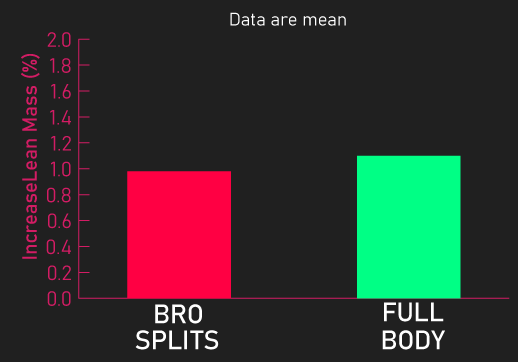
Now, when performing higher training volume (more than 12 weekly sets), the research is conflicting on whether lower or higher frequency training is better. Some find higher frequency to be better, others lower frequency, and some with no differences. We’ve more thoroughly examined this in our ultimate guide to training frequency article.
Nonetheless, it’s clear to see for hypertrophy, the research fails to demonstrate lower frequency training is superior. Higher frequency training appears perfectly viable.
As for strength, a 2018 meta-analysis by Grgic et al. combined 7 studies and found with all other weekly training variables equal (again, including weekly sets per muscle group), training frequency had no impact.
All 7 studies had subjects train with a total of 12 or fewer weekly sets per muscle group. Thus, with these volumes, both low and high-frequency training appear similarly effective for strength.
When performing more than 12 weekly sets per muscle group, one study by Bartomolemi et al. compared training muscles with a frequency of 3/4x per week to only once a week.
Strength gains were superior for the 3/4x frequency group.
However, this isn’t a consistent finding.
3 other studies indicate with more than 12 weekly sets per muscle group, lower and higher frequencies were similarly effective for strength gains.
Fascinatingly, returning to the 2018 Grgic et al. meta-analysis, the researchers found when combining studies that did not equate weekly sets between lower and higher frequency training (resulting in the higher frequency training groups performing more weekly sets on their exercises), strength gains were greater with higher frequency training.
This suggests using higher frequency training as a tool to help you perform more weekly sets may be an effective way to produce greater strength gains.
In total, the research suggests lower frequencies are not superior for strength gains. Higher frequency training is perfectly viable.
In fact, the Grgic et al. meta-analysis suggests higher training frequencies, when used in a way to accumulate more weekly sets, can effectively produce more strength adaptations.
Moving forward, I wanted to discuss one point behind why high-intensity folks seemingly advocate lower frequencies.
I think they assume that the body’s capacity to recover is very limited.
I’m not saying the body can handle an infinite amount of training. There’s going to be a point above which more training will cause recovery problems.
Yet, I feel high-intensity folks significantly underestimate where this point may be.
After all, the repeated bout effect exists.
Ever notice how when you first start training, extreme soreness and muscle performance decrease in the multiple days after. But after further weeks of training, soreness is minimal and no longer is muscle performance hampered for multiple days after.
This is because of the repeated bout effect, the name given to the range of adaptations your body produces to make you resilient to damage, soreness, and force production decreases.
It’s not clear precisely what creates the repeated bout effect, but a 2017 study hypothesized neural, muscle-tendon, connective tissue, and inflammatory adaptations may all play a role.
Now, many studies aiming to examine the time course of recovery after lifting weights only do so after a single training session.
For example, this study found after trained men performed a session consisting of 3 sets of repetitions to failure with a 12 rep-max load on the bench press and squat, performance was still not fully recovered 48 hours after the session.
Some may say this data indicates if your training with multiple sets to failure, more than 48 hours of rest is required between sessions.
However, this suggestion ignores the fact the recovery time course was only examined after one training session. What would happen to the recovery time course after repeatedly training with multiple sets to failure?
Due to the repeated bout effect, we’d expect recovery durations to progressively become shorter.
My favorite study demonstrating this concept is this paper.
They had 12 previously untrained perform 5 sets of 15 maximal eccentric only leg extension repetitions on an isokinetic dynamometer once a week for 10 weeks.
Due to the machines, training loads would have increased as subjects got stronger.
5 sets of 15 MAXIMAL eccentric repetitions are extremely fatiguing.
Eccentric training is known to produce more soreness and damage compared to normal training when first exposed to it.
The data from the study demonstrates this.
After the first training session, Creatine kinase (an indirect measure of muscle damage) was significantly elevated a day later, and muscle soreness and maximal isometric force production were still decreased 5 DAYS after the session.
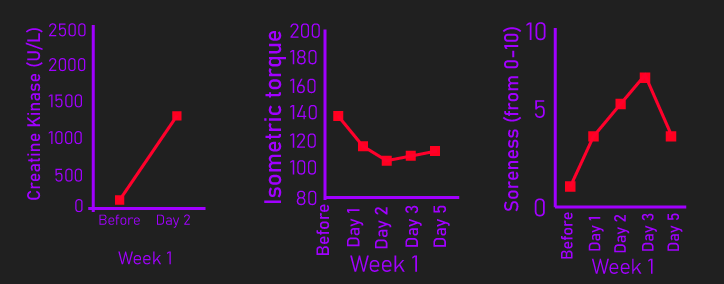
However, as the training weeks progressed, the repeated bout effect kicked in and all markers gradually decreased. This is something I feel people underappreciate.
By the 10th week, the training session produced NO soreness, NO creatine kinase increases, and NO decreases in maximal isometric force in the upcoming days.

In other words, subjects were recovering within 24 hours of the intense eccentric training session after 10 weeks of consistent training.
Again, I’m not saying your body can recover from an infinite amount of training, rather the body can adapt robustly and handle a good amount of training over time. I feel high-intensity training regimes underappreciate this.
Part VII: Positives of High-Intensity Training
I want to make it clear that by no means what this article aim to discredit or hate on high-intensity training. The goal was to evaluate if high-intensity training is supported by the current literature in the most non-bias way I can. I hope I was able to accomplish this.
I’d like to say Mike Mentzer’s book is highly interesting and in my view extraordinarily well written. I feel Mike Mentzer was simply interpreting the data and knowledge that was available at the time he composed the book (the early 2000s).
Since then, we have a substantial amount of new research, and presumably in the next 20 years, more will emerge.
Nevertheless, I still wanted to discuss aspects of high-intensity training I think are positive in some way.
We mentioned training to failure does not appear to be essential. Stopping 5-3 reps from failure seems to be sufficient for maxing strength and hypertrophy gains, respectively.
Yet, stopping a certain number of reps from failure requires you accurately judge how far from failure you are.
This is challenging, and having experience with training to failure is likely required to do this.
Psychologically, it’s easier to train to failure when performing only one set per exercise.
So high-intensity training can be a great way to accustom yourself to the feeling of training to failure.
Progressing on, it’s important to remember high-intensity training will unquestionably still build a substantial amount of muscle.
We’ve mentioned how performing 3 sets per exercise tends to be better than 1 set for strength and hypertrophy.
Yet, performing 3 sets does not give you 3x the more strength and hypertrophy versus performing 1 set, rather only marginally more gains.
Returning to the Ralson et al. meta-analysis which found greater strength gains with high volume versus low volume training, the effect size difference was 0.18, which is interpreted as being a trivial difference only.
As for the Schoenfeld et al. meta-analysis which found greater hypertrophy with high volume versus low volume training, the effect size difference was 0.24, which is interpreted as a small difference only.
Now, it’s important to remember the studies involved in these analyses largely lasted 12 weeks or less, so these trivial to small gains achieved with 3 sets versus 1 set may become more pronounced long-term.
Regardless, it’s clear you’re still going build a lot of muscle with low volume training like high-intensity training. Many people, for one reason or another, may not want to invest extra time in higher volume training for slightly more gains. So high-intensity training can be a great time-efficient method for these folks.
Finally, and this is a very important point I want to emphasize, it might be possible that some individuals truly grow more with lower volume training versus higher volume training.
Remember all the research findings presented thus far are the average results.
Such results are not always applicable to an individual.
Matter of fact, this study demonstrates this.
16 men and 18 women trained the unilateral leg press and unilateral leg extension with a 7-10 rep-max load, three times per week for 12 weeks.
With one-leg, subjects trained each exercise with only one set. With the other leg, they trained each exercise with three sets.
Cross-sectional area of the quadriceps was measured before and after the study.
The graph below shows the individual responses for each participant. The Y-axis shows the cross-sectional area increases for the leg that trained with 3 sets, and the X-axis shows the cross-sectional area increases for the leg that trained with 1 set.
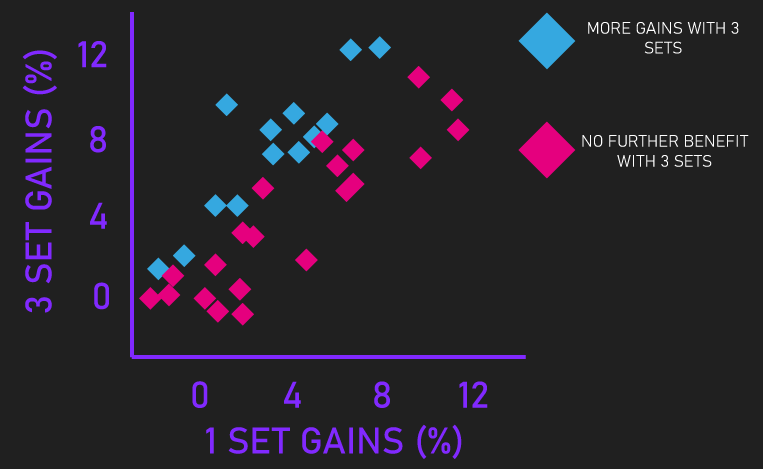
The results show a near 50/50 split, with 50% seeing better gains with 3 sets per exercise, and the other 50% seeing similar or more gains with 1 set.
The researchers also looked at strength (they averaged out the results from 3 different strength tests), and the findings were similar, a near 50/50 split.

These findings truly surprised me, and if they can be replicated on a larger scale, they might suggest many folks experience no benefit with higher volumes.
However, it’s essential to remember only 34 subjects were in this study, so it’s very difficult to say this exact distribution applies to everyone.
Moreover, all these subjects were untrained. As mentioned , there’s data showing increasing set numbers in trained individuals benefits hypertrophy, so I’m skeptical these distributions hold true for trained individuals.
Regardless, it is likely true some individuals grow at least the same or even possibly more with lower volume training, and high-intensity training may be great for these folks.
Part VIII: Conclusions
Crystalizing everything, the current literature does not suggest high-intensity training is optimal for building muscle or strength.
Training to failure isn’t essential, higher volumes tend to be better than lower volumes on average, and higher training frequencies are also perfectly viable for gains.
Still, high-intensity training will build a substantial amount of muscle and strength, and for some individuals, low-volume training like this could actually be optimal.
Remember to feel free to check out the Alpha Progression App if you’re interested. Also feel free to check out our free bench press e-book below.


The results show a near 50/50 split, with 50% seeing better gains with 3 sets per exercise, and the other 50% seeing similar or more gains with 1 set.
I definitely fall into the latter category. Having used HIT/Heavy Duty, successfully, for 46 years.